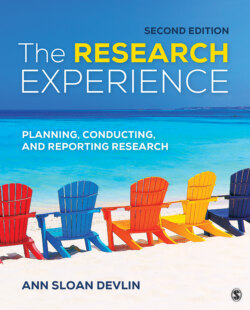Читать книгу The Research Experience - Ann Sloan Devlin - Страница 22
Coincidence (Gambler’s Fallacy) and Representativeness (Base Rate)
ОглавлениеTwo other important aspects of this category “Problems in Pseudoscientific Thinking” according to Shermer (1997) are coincidence (gambler’s fallacy) (pp. 53–54) and representativeness (base rate) (pp. 54–55). These two aspects frequently appear when we make assumptions in the research process. In the gambler’s fallacy, we commit a logical fallacy and lose sight of the facts of probability; we think an event is less likely to occur if it has just occurred or that it is likely to occur if it hasn’t for a while. When we toss a coin, we have a 50–50 chance of heads. Each toss of the coin is an independent event. Yet if we have seen three heads in a row, we may be very likely to predict that the next toss will yield tails when, in fact, the odds of a tail (or head) appearing on the next coin toss is still 50–50.
Coincidence (gambler’s fallacy): Thinking that an event is less likely to occur if it has just occurred or that it is likely to occur if it hasn’t occurred for some time (e.g., assuming a slot machine will pay off because it hasn’t for the past few hours).
Representativeness (base rate): One of the heuristics talked about by Kahneman and Tversky (1972) in which we make decisions based on how representative or characteristic of a particular pattern of events data are (e.g., people think the birth order BGBBGG is more representative of a sequence of births than is BBBGGG).
A related idea is the mistaken belief that correlation (for example, of two co-occurring events) is causation. Superstitions are an example of this erroneous thought process. Athletes are notorious for superstitions (Vyse, 1997). For example, if you win two games in a row in which you tie your left shoelace first as you prepared for the game, you may believe that tying that left shoe first influenced the victories. These two events (left shoe tying and game victory) are correlated, that is, when one event happened the other also happened, but shoe tying did not achieve the victory. Humans are pattern seekers because they are limited information processors. Humans look for causal relationships that may not exist; they see patterns (a series of coins coming up heads) and predict that the next coin toss will produce a tail. Humans make this prediction because such an outcome would be more representative of the occurrence of events as they know them. This is an aspect of representativeness (which was discussed earlier in the chapter).
In representativeness, we are on the lookout for events in the world that match or resemble the frequency of occurrence of those events in our experience. When we encounter a situation that does not look representative, we are likely to ignore, disregard, or mistrust it. As we have already discussed in this chapter, Kahneman and Tversky’s work is full of examples of problems in thinking related to representativeness. The base rate is the frequency with which an event (e.g., twins, a hole in one, or perfect SATs) occurs in a population. We may have little knowledge of the actual base rate of events in a population, and we often overestimate the occurrence of events (e.g., likelihood of a plane crash or likelihood of winning the lottery). Our overestimation of the base rate may be influenced by the availability heuristic (discussed earlier in the chapter). If we have read or heard about a recent plane crash, for example, we are more likely to overestimate the occurrence of a plane crash for our upcoming trip.
The odds of dying from a motor vehicle accident are far greater than the odds of dying from a commercial airline accident. Likewise, we are far, far more likely to die from heart disease than we are from homicide (Kluger, 2006). In other words, we are not logic machines, and we don’t carry around statistics in our heads; instead we carry estimates of events based on the frequency with which we have encountered them, and exposure to media typically elevates our estimates of the base rate, or the frequency with which events actually occur.
These errors in understanding the base rate underscore the importance in research of assessing the degree to which participants in your study may have familiarity with the topics under investigation. For example, if you were evaluating patients’ reactions to hospitalization, you would certainly want to ask a question about the number of prior hospitalizations. You want to ask yourself what aspects of a participant’s background might have relevance and possibly influence your research. As another example, if you were investigating students’ satisfaction with their educational institution, it might be helpful to know if the college they attend was their first choice.
